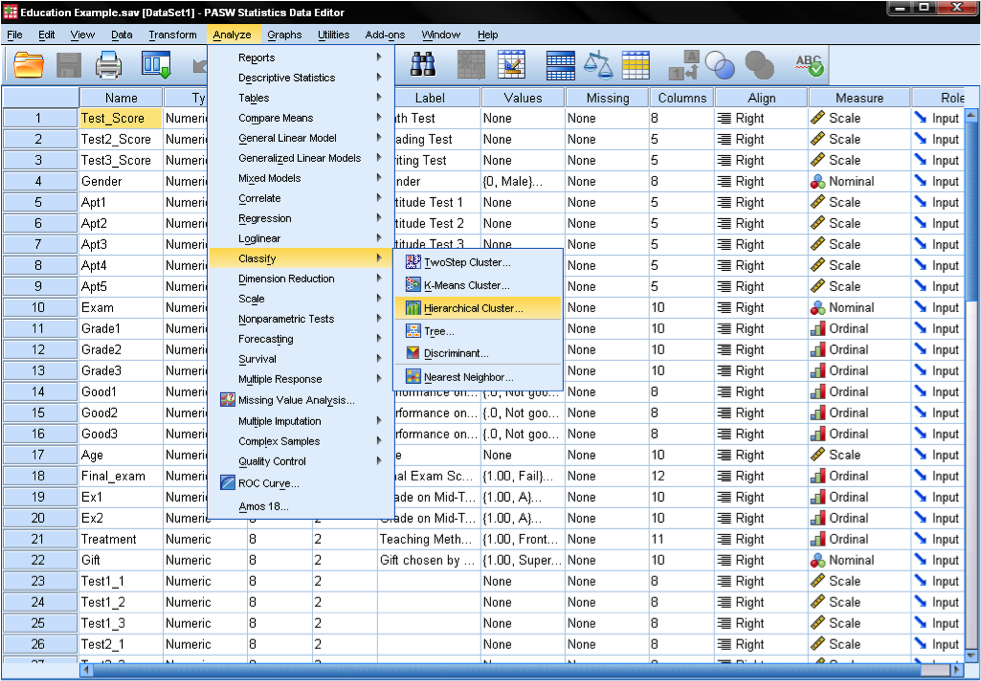Q Cluster Analysis
Cluster Analysis Cluster Analysis. In this article we will explore this.

Customer Clustering Cluster Segmentation Analysis Optimove
Cluster analysis is also called segmentation analysis or taxonomy analysis.

Q cluster analysis. Two entities are bracketed together whenever they share the appropriate number of descriptors with each other. A monograph on cluster analysis. The goal is that the objects within a group be similar or related to one another and different from or unrelated to the objects in other groups.
This is why most data scientists often turn to it when they have no idea where to start or what to expect. A collection of data objects Similar to one another within the same cluster Dissimilar to the objects in other clusters Cluster analysis Grouping a set of data objects into clusters Clustering is unsupervised classification. Users of clustering.
The Cluster Analysis is an explorative analysis that tries to identify structures within the data. Those groups are compared and contrasted with other groups to derive information about the observations. Prepare Data mydata.
It requires the analyst to specify the number of clusters to extract. Q-analysis algorithm equivalently single link cluster analysis algorithm results q 10 11 X2 X3 Xa X Xs X6 XT corresponds to a given number of descriptors. Because it is exploratory it does not make any distinction between dependent and independent variables.
Cluster analysis is a type of unsupervised machine learning technique often used as a preliminary step in all types of analysis. But on the other hand the objective of cluster analysis is to address the heterogeneity. The different cluster analysis methods that SPSS offers can handle binary nominal ordinal and scale interval or ratio data.
For factor analysis the usual objective is to explain the correlation with a data set and understand how the variables relate to each other. This chapter introduces cluster analysis including the Q-mode cluster analysis Q-mode and R-mode. K-means clustering is the most popular partitioning method.
The supposed steps in the algorithm for the single-linkage method are. Cluster analysis groups data objects based only on information found in the data that describes the objects and their relationships. The objective of cluster analysis is to find similar.
The author compares the predictive performance of cluster analysis and Q-type factor analysis as disaggregation methods in hybrid conjoint modeling. Cluster analysis like reduced space analysis factor analysis is concerned with data matrices in which the variables have not been partitioned beforehand into criterion versus predictor subsets. Table of Contents Overview 10 Data examples in this volume 10 Key Concepts and Terms 12 Terminology 12 Distances proximities 12 Cluster formation 12 Cluster validity 12 Types of cluster analysis 14 Types of cluster analysis by software package 14 Disjoint clustering 15 Hierarchical clustering 15 Overlapping clustering 16 Fuzzy clustering 16 Hierarchical.
Prior to clustering data you may want to remove or estimate missing data and rescale variables for comparability. Cluster analysis is a statistical method for processing data. Cluster analysis is a multivariate method which aims to classify a sample of subjects or ob- jects on the basis of a set of measured variables into a number of different groups such that similar subjects are placed in the same group.
A point on the plot corresponds to one of the quantiles of the second distribution plotted against the same quantile of the first distribution. One strategy for constructing a hierarchy of partitions in a cluster analysis is agglomerative hierarchical clustering. Thus the line is a parametric curve with the parameter which.
The greater the similarity or. One key difference between cluster analysis and factor analysis is the fact that they have distinguished objectives. Cluster analysis is also called segmentation analysis or taxonomy analysis.
First the set of intervals for the quantiles is chosen. The results indicate that cluster- and Q-type-factor-based models perform about equally well in predictive validity terms. In statistics a QQ plot is a probability plot which is a graphical method for comparing two probability distributions by plotting their quantiles against each other.
Join the MathsGee QA community and get study support for success - MathsGee QA provides answers to subject-specific questions for improved outcomes. It is very useful for exploring and identifying patterns in datasets as not all data is tagged or classified. It works by organizing items into groups or clusters on the basis of how closely associated they are.
Cluster analysis is a form of exploratory data analysis in which observations are divided into groups that share common characteristics. The paper however suggests the need for more empirical research. More specifically it tries to identify homogenous groups of cases if the grouping is not previously known.
What is Cluster Analysis. Cluster analysis deals with separating data into groups whose identities are not known in advance.

Conduct And Interpret A Cluster Analysis Statistics Solutions

The Complete Guide To Clustering Analysis K Means And Hierarchical Clustering By Hand And In R Stats And R

The Complete Guide To Clustering Analysis K Means And Hierarchical Clustering By Hand And In R Stats And R
Posting Komentar untuk "Q Cluster Analysis"